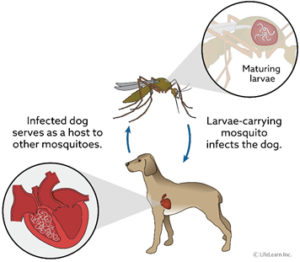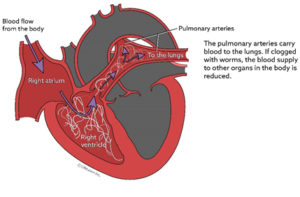Heartworm disease is a serious and potentially fatal disease caused by a blood-borne parasite. It’s unique in that the parasite requires a mosquito as an intermediate host before it can complete its life cycle in the dog. Unfortunately, clinical signs of infection can take years to appear, doing serious harm in the meantime. This includes clogging the heart and major blood vessels leading from the heart, including the pulmonary artery.

While a simple blood test can diagnose this disease, there is risk involved in the lengthy treatment plan which require complete rest, a difficult feat with most dogs. To help you understand more, here are ten facts every dog owner needs to know about heartworm disease or, in other words, ten reasons to take heartworm prevention very seriously:

- Female adult heartworms are 6-14″ long and 1/8″ wide; males are about half the size of females. One dog may have as many as 300 worms present when diagnosed, and these worms can live up to five years. During this time, females produce millions of offspring called microfilaria which live mainly in the small vessels of the bloodstream.
- By clogging the main blood vessels in the heart, the blood supply to other organs of the body is reduced, particularly blood flow to the lungs, liver, and kidneys. Decreased blood flow and decreased oxygen delivery can cause these organs to malfunction.
- Since transmission requires the mosquito as an intermediate host, the disease is not spread directly from dog to dog. Spread of the disease therefore coincides with mosquito season.
- Canine heartworm disease occurs all over the world. In the United States, the highest numbers of reported cases are within 150 miles of the Gulf of Mexico and the Atlantic Ocean coastlines and along the Mississippi River and its tributaries. However, the disease is spreading and is now found in most regions of the United States, including Colorado, California, Oregon, and Washington.
- Because it takes several years before dogs show clinical signs of infection, the disease is diagnosed mainly in two- to eight-year-old dogs. The signs depend on the number of adult worms present, the location of the worms, the length of time the worms have been in the dog, and the degree of damage that has been sustained by the heart, lungs, liver, and kidneys.
- The most obvious clinical signs of heartworm disease are a soft, dry cough, shortness of breath, weakness, listlessness, and loss of stamina. All of these signs are most noticeable following exercise. Your veterinarian may notice abnormal lung and heart sounds when listening to the chest with a stethoscope. In advanced cases, congestive heart failure may cause the abdomen and legs to swell from fluid accumulation. There may also be evidence of weight loss, poor condition, and anemia. Severely infected dogs may die suddenly during exercise or excitement.
- In most cases, one or more simple blood tests will diagnose heartworm disease. Further diagnostic tests are often required in heartworm-positive dogs to determine if the dog can safely undergo heartworm disease treatment.
- Although fatalities are rare, there is some risk involved in treating dogs with heartworms. An injectable drug is administered in a series of injections. Your veterinarian will determine the specific injection schedule according to your dog’s condition. Most dogs receive an initial injection, followed by a 30-day period of rest, and then two more injections that are given 24 hours apart. Many dogs will also be treated with an antibiotic to combat potential infection with bacteria that inhabit the heartworm.
- Complete rest is essential after treatment. The adult worms die in a few days and start to decompose. As they break up, they are carried to the lungs, where they lodge in the small blood vessels and are eventually reabsorbed by the body. This resorption can take several weeks to months, and most post-treatment complications are caused by these fragments of dead heartworms. This can be a dangerous period, making it absolutely essential that the dog be kept as quiet as possible and is not allowed to exercise for one month following the final injection of heartworm treatment.
- Dogs with severe heartworm disease may require additional antibiotics, pain relief medications, special diets, diuretics to remove fluid accumulation in the lungs, and/or drugs to improve heart function prior to treatment for the heartworms. Even after the heartworms have been killed, some dogs may require lifetime treatment for heart failure. This includes the use of diuretics, heart medications such as ACE-inhibitors, beta-blockers or cardiac glycosides, and special low-salt diets.
The most obvious clinical signs of heartworm disease are a soft, dry cough, shortness of breath, weakness, listlessness, and loss of stamina. All of these signs are most noticeable following exercise.
The good news? You can prevent your dog from getting heartworms by using a heartworm preventive. With the safe and affordable heartworm preventives available today, no pet should ever have to endure this dreaded disease. Consult with us to determine which heartworm preventive program is best for your dog.

